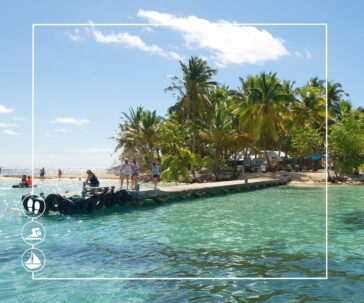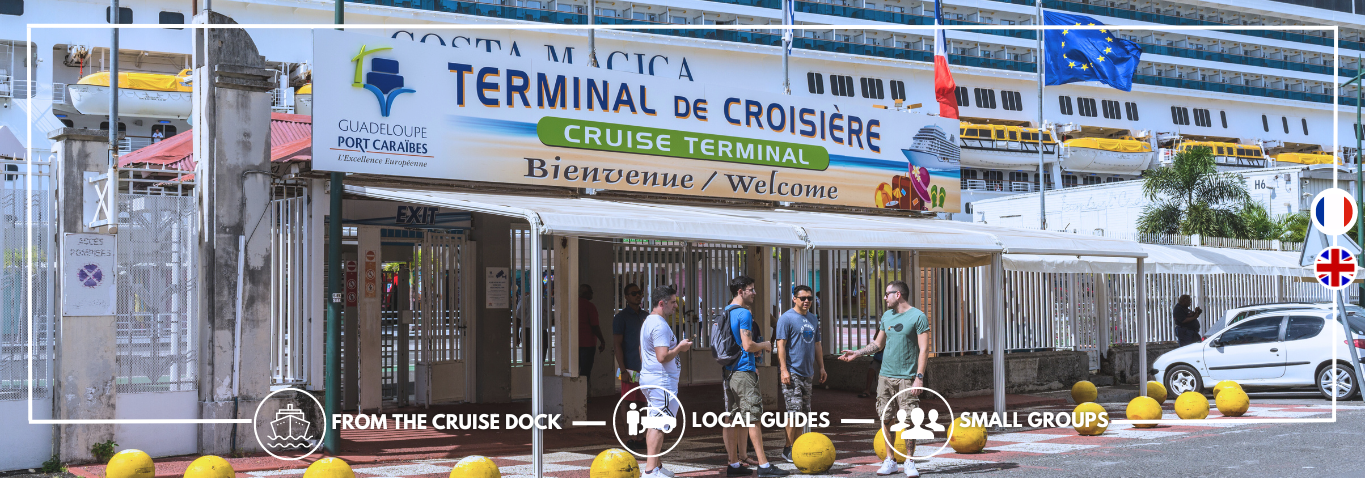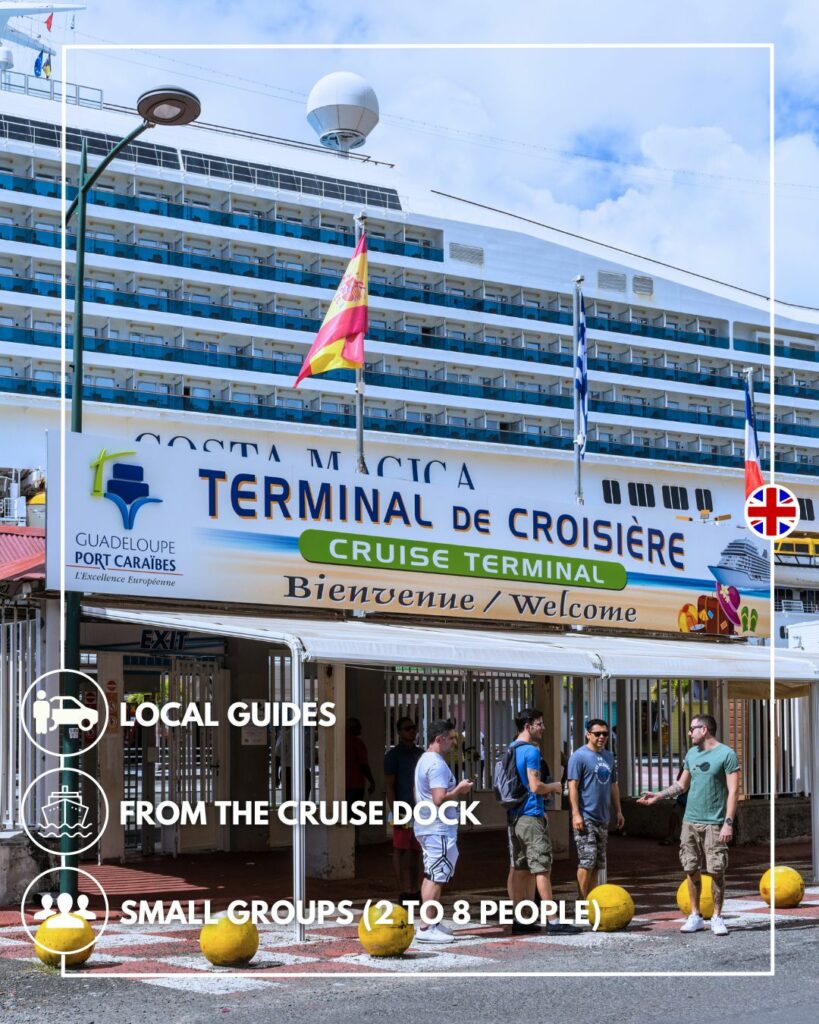€85
/each
Book a Guadeloupe excursion from Pointe-à-Pitre Cruise Terminal or Deshaies Port!


Our shore excursions are adapted to the docking times in Guadeloupe, giving you enough time to enjoy your day ashore, while ensuring a timely return to the cruise terminal. Your local English-speaking guide will be at your side throughout the excursion.
14 days Before Excursions.
with Local & Bilingual Guides.
Our driver and guide will be waiting for you at the main exit of the Pointe-à-Pitre cruise terminal. You should follow the signs for ‘SORTIE CENTRE VILLE’ located near the terminal’s taxi rank. Your guide will be waiting for you in front of this exit with a sign bearing your name.
The sooner the better. A minimum of 24 hours in advance is required, but activities do sell out, so make yours as soon as you know that you want to take it.
The local currency in Guadeloupe is the Euro. Although U.S. dollars may be accepted at some locations, it’s best to rely primarily on major credit cards for larger purchases, and cash for small purchases. Be sure to check with your credit card company to see if you’ll be charged foreign currency conversion fees. Visa and MasterCard are generally accepted, but most merchants do not accept American Express or Discover cards.
You’ll need your ATM card to obtain Euros for smaller purchases. You must establish a 4 digit PIN for your account prior to departure or your card may not be accepted by ATMs on the island.
As part of France, the official language of Guadeloupe is French. But our local guides are fluent in English.
It is not mandatory to have travel insurance to enter Guadeloupe, but it is recommended.
If you’re stopping off in Guadeloupe for a day and prefer to spend it at the beach, we suggest the following 5 beaches:
Plage de la Datcha, Le Gosier (20 minutes from Pointe-à-Pitre cruise terminal)
Plage de la Datcha, in Le Gosier, is probably one of the best-known beaches in Guadeloupe, with its white sandy beach and magnificent views over the islet of Le Gosier. There are plenty of water sports, bars and restaurants to keep you entertained all day long. To get there, take a taxi from the cruise terminal in Pointe-à-Pitre. Prices vary between 15 and 20 euros per person. You can also get there by bus. Google Maps will certainly help you plan your route.
Plage de la Caravelle or Plage du Bourg, Sainte-Anne (about half an hour from the Pointe-à-Pitre cruise terminal)
These two magnificent white-sand beaches are very popular with tourists and locals alike. However, the beach in the village of Sainte-Anne is better served in terms of transport, restaurants and facilities (toilets, shower cubicles, etc.). Taxis charge a minimum of 35 to 40 euros per person. Please note: please agree a return time with your driver at least one hour before the departure of your boat.
Grande-Anse beach in Deshaies (60 minutes from Pointe-à-Pitre cruise terminal)
This beach is undoubtedly the longest in Guadeloupe. Well served by restaurants, it will delight you during your stopover in Guadeloupe. Beware, however, as this beach can be very choppy due to the sea currents. So always stay on the shore! Access costs around €50 per person.
Plage de Malendure, Bouillante (60 minutes from Pointe-à-Pitre cruise terminal)
Situated opposite the famous Ilets Pigeon, Malendure beach is a must for divers and lovers of the underwater world. A meeting point for divers, it offers tourist activities such as snorkelling, kayaking, scuba diving courses and glass-bottom boat trips. To get there, you’ll need to spend around €40 to €50 per person!
Please note: taxi and other fares are given as an indication only and may change over time. We therefore recommend that you check the rates in force for the period of your stay in Guadeloupe.
If you’re more interested in outdoor activities, Guadeloupe has plenty to offer during your cruise stopover in Pointe-à-Pitre or Basse-Terre:
Deshaies Botanical Garden (60 minutes from the Pointe-à-Pitre cruise terminal)
The Deshaies Botanical Garden is a botanical garden located in the commune of Deshaies, on the island of Basse-Terre in Guadeloupe. The garden boasts an impressive array of tropical flowers and plants, with more than 1,000 species, including bougainvillea, hibiscus and the porcelain rose, as well as a large number of trees such as the cheese tree, baobab, mapou, sausage tree, breadfruit tree and double royal palm, not to mention the talipot, Guadeloupe’s only palm tree. There is also an aviary of lorikeets, a small village of macaws and Caribbean red flamingos. To get there, you’ll need to pay around €40 per person by taxi. Admission costs 17.50 euros for adults.
Jardin botanique de Valombreuse, Petit-Bourg (30 minutes from Pointe-à-Pitre cruise terminal)
Nestling in a luxuriant valley in the “green” commune of Petit Bourg, this magical world reveals the wealth of an exceptional botanical collection: orchids, ferns, hoyas, tillandsias, anthuriums, alpinias, porcelain roses… enhance the botanical value of the site, surrounded by hundred-year-old trees. Birds haven’t been forgotten either, as a multitude of them find shelter and food here. Water also plays an essential role at Jardin de Valombreuse: the Japanese ponds and streams offer visitors a cool, contemplative and romantic break. To get there, you’ll need to pay around €25 per person by taxi. Admission is €16.50 for adults.
Guadeloupe Zoo at Parc Des Mamelles, Petit-Bourg (35 minutes from Pointe-à-Pitre cruise terminal)
In the heart of the Basse-Terre massif, the Parc des Mamelles devotes 4 hectares of tropical forest to the conservation of rare or endangered animal species. Located on the Route de la Traversée, on the edge of the Guadeloupe National Park, the park stands out for its tranquillity and perfectly natural setting. A modern-day Noah’s Ark, it is home to some 85 species of animals from the Caribbean and French Guiana: mammals, birds, reptiles and arthropods, totalling more than 450 individuals. They thrive in a verdant setting where more than a thousand species of plant grow. Taxis cost around €40 per person. Admission is €17.50 for adults.
La Cascades-aux-Écrevisses, Petit-Bourg (35 minutes from the Pointe-à-Pitre cruise terminal)
The Cascade aux écrevisses is a waterfall on the Rivière aux écrevisses in Petit-Bourg, on the island of Basse-Terre in Guadeloupe. It is one of the most popular tourist attractions. It receives around 200,000 visitors a year. The waterfall offers a swimming pool in the middle of the tropical forest. To get there, all you have to do is walk about ten minutes from the Route de la Traversée. Access to the Cascade is entirely free, including parking. Taxis charge around €40 per person.
Please note: taxi and other fares are given as an indication only and may change over time. Please check the rate in force for the period of your stay in Guadeloupe.
If you prefer to discover Guadeloupe through its culture, know-how and history, we suggest the following activities, which you can do on a guided tour of Guadeloupe or by taxi from the Pointe-à-Pitre cruise terminal:
The ACTe Guadeloupe Memorial, Pointe-à-Pitre (15 minutes from the Pointe-à-Pitre cruise terminal)
The ACTe Memorial or “Caribbean Centre for Expression and Remembrance of the Slave Trade and Slavery” is a memorial. It is located in the port of Pointe-à-Pitre. The ACTe Memorial is a place dedicated to the collective memory of slavery and the slave trade, open to the contemporary world. The ACTe Memorial is the most ambitious memorial ever devoted to slavery. Admission costs €15 for adults.
Saint-John Perse Museum, Pointe-à-Pitre (10 minutes from the Pointe-à-Pitre cruise terminal)
Located in the historic district of Pointe-à-Pitre, in the Maison des Illustres, the Saint-John Perse museum retraces the life of Alexis Léger, better known as Saint-John Perse, winner of the Nobel Prize for Literature, whose writings were strongly influenced by his stay in Guadeloupe. Admission is free.
The Musée départemental d’Art et d’Histoire (MUSARTH), Pointe-à-Pitre (10 minutes from the Pointe-à-Pitre cruise terminal)
The Musée départemental d’Art et d’Histoire de Pointe-à-Pitre, formerly the Musée Victor Schœlcher, was founded in 1887 in response to the wishes of the famous abolitionist. Keen to promote culture in all its forms among a population that had been freed from slavery forty years earlier, Schœlcher gave the Conseil Général de la Guadeloupe a collection of works ranging from Antiquity to the 19th century, as well as personal objects and travel souvenirs. Admission is free.
Musée du Rhum, Distillerie Reimonenq, Sainte-Rose (60 minutes from Pointe-à-Pitre cruise terminal)
At the Musée du Rhum, you’ll discover much more than just rum. From cane cultivation to processing, the rum production circuit will hold no secrets for you. You’ll also discover the butterfly gallery, with species endemic to the islands of Guadeloupe, and a collection of miniature sailing ships, retracing the epic of navigation. Admission costs €6 per person.
Musée du café, Vieux-habitant (80 minutes from Pointe-à-Pitre cruise terminal)
The Chaulet coffee museum lets you discover the history of coffee. Discover the history of coffee through time and on five continents. From 1721 to the present day, they tell you the story of coffee in Guadeloupe: the life, gestures, customs and production techniques of our ancestors. From picking to roasting, you’ll discover all the operations involved in transforming the coffee bean into a beverage with a host of virtues. You’ll understand why “Grigne au Vent” is ranked among the best coffees in the world. Admission charge.
La Maison Du Cacao – Ecomuseum, Pointe-Noir (65 minutes from Pointe-à-Pitre cruise terminal)
Located in the heart of Guadeloupe’s ancient cocoa-growing region, La Maison du Cacao will introduce you to Guadeloupe’s culinary heritage. From the cocoa pod to the chocolate bar, you’ll discover Guadeloupe’s ancestral knowledge of this product that thrills our taste buds. Immerse yourself in the fascinating world of cocoa during a visit to the dedicated eco-museum, then round off this immersive experience with a commented tasting session highlighting the flavors and subtleties of chocolate. Admission required.
La maison de la banane, Trois-Rivières (50 minutes from Pointe-à-Pitre cruise terminal)
La Maison de la banane is first and foremost a real farm, with its banana plantation and packing station. You’ll start your tour in a traditional Guadeloupean manor house. Your visit will then take you on a tour of banana growing and processing. If you come during the cutting season, you’ll see the bunches circulating on cable cars. Admission charge.
Are you the type of person who likes to discover a destination through its flavours and culinary specialities? Then you’ve come to the right island! Guadeloupe is packed with dishes and flavours that have made its reputation in Europe and around the world. Here’s a sample you won’t want to miss:
Accras fritters
Acras or accras or akras or achras are small fried fritters made from cod, herbs and spices, with varying degrees of spice. They are a traditional Guadeloupean appetiser, served as an aperitif or starter, and can be served with other fish, shellfish or vegetables.
Fried balaou fish
The balaou is a small, elongated grey fish with a pointed beak, found in tropical waters. Balaou is a staple of Guadeloupean cuisine, and thus of local restaurant menus. It is usually served grilled or fried, with or without breadcrumbs. Depending on the chef’s preference, it can be served as a main course, a snack or an aperitif.
Dombrés
Dombrés (or dombwé in Guadeloupean Creole, and dombrey or boy in Haitian Creole) are a Caribbean delicacy. They are small balls, or patties, of cooked flour to which a sauce and all kinds of meat, fish or prawns, as well as kidney beans, are added.
West Indian fish court-bouillon
Fish court-bouillon is a quick way of cooking fish in a spicy red sauce. In Guadeloupe, this red sauce used to be made from roucou seeds, later replaced by tomatoes… This dish is usually accompanied by rice or West Indian vegetables (plantain, yam, breadfruit, etc.).
Colombo curry
Colombo (or Antillean curry in Guadeloupe and Martinique) is both a blend of spices (a variant of curry, garam masala or ras el-hanout) and an emblematic recipe of Antillean cuisine, present since the 19th century and derived from kuḻambu, a preparation of the cuisine of south-east India and Sri Lanka.
In the West Indies, colombo is a culinary preparation based on a wide range of vegetables and spices, as well as chicken, pork, lamb, goat, beef, fish, prawns or lobsters… The meat or fish is marinated with the colombo spice blend and the rest of the marinade for one hour to one night, to retain all the flavour of the spices, before being cooked.
Tourment d’amour
A traditional Guadeloupe cake, Tourment d’amour originates from the islands of Les Saintes, Terre de Haut and Terre de Bas. It is a small pie-shaped cake made from shortcrust pastry, exotic jam and sponge cake. The most commonly used jam is coconut jam, but you can also vary the flavours with banana or guava jam.
Caca bœuf cake
Caca bœuf” is a pastry made with battery syrup and a range of exotic flavours such as coconut, guava, pineapple and many others.
Agricole rhum from Guadeloupe
Agricole rhum or rum, originally called rhum z’habitant in the French West Indies, is a cane alcohol produced by fermenting and distilling the juice of the sugar cane plant, the vesou.
Ti Punch cocktail
Ti-punch or ti-ponch (meaning “little punch” in West Indian Creole) is a cocktail made with rum, lime and battery syrup, brown cane sugar or sugar cane syrup.
Coconut punch
Coconut punch is a traditional West Indian liqueur made from natural coconut, cane syrup and white agricultural rum.